door lock HONDA ACCORD COUPE 2014 9.G Owners Manual
[x] Cancel search | Manufacturer: HONDA, Model Year: 2014, Model line: ACCORD COUPE, Model: HONDA ACCORD COUPE 2014 9.GPages: 593, PDF Size: 22.22 MB
Page 1 of 593

Contents
This owner’s manual should be considered a permanent part of the
vehicle and should remain with the vehicle when it is sold.
This owner’s manual covers all models of your vehicle. You may find
descriptions of equipment and features that are not on your
particular model.
Images throughout this owner’s manual (including the front cover)
represent features and equipment that are available on some, but
not all, models. Your particular mo del may not have some of these
features.
This owner’s manual is for vehicles sold in the United States and
Canada.
The information and specifications in cluded in this publication were
in effect at the time of approval for printing. Honda Motor Co., Ltd.
reserves the right, however, to discontinue or change specifications
or design at any time without notice and without incurring any
obligation.2 Safe Driving P. 27
For Safe Driving P. 28 Seat Belts P. 32 Airbags P. 39
2Instrument Panel P. 67
Indicators P. 68 Gauges and Displays P. 89
2Controls P. 105
Clock P. 106 Locking and Unlocking the Doors P. 108
Opening and Closing the Moonroof* P. 130
Adjusting the Seats P. 148
Climate Control System
* P. 169
2 Features P. 173
Audio System P. 174 Audio System Basic Operation P. 180, 202, 235
Customized Features P. 298 HomeLink® Universal Transceiver* P. 336
2 Driving P. 415
Before Driving P. 416 Towing a Trailer P. 421
Refueling P. 479 Fuel Economy P. 481
2Maintenance P. 483
Before Performing Maintenance P. 484 Maintenance MinderTM P. 487
Checking and Maintaining Wiper Blades P. 521
Heating and Cooling System
*/Climate Control System* Maintenance P. 535
2 Handling the Unexpected P. 541
Tools P. 542 If a Tire Goes Flat P. 543
Overheating P. 556 Indicator, Coming On/Blinking P. 558
2Information P. 567
Specifications P. 568 Identification Numbers P. 572
Emissions Testing P. 575 Warranty Coverages P. 577
Page 5 of 593
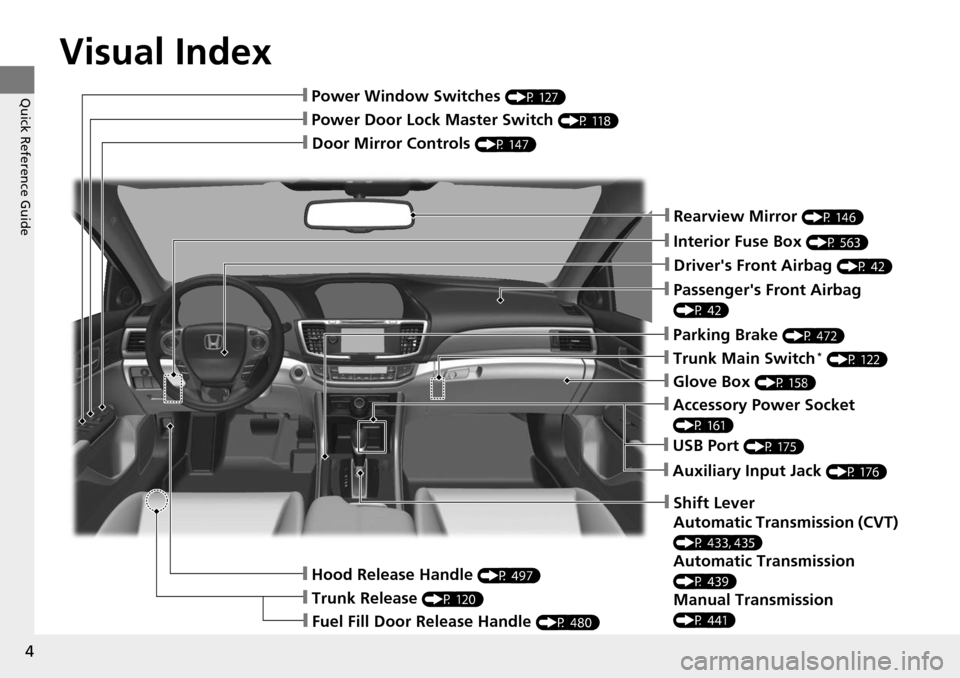
Visual Index
4
Quick Reference Guide
❙Door Mirror Controls (P 147)
❙Passenger's Front Airbag
(P 42)
❙Parking Brake (P 472)
❙Glove Box (P 158)
❙Rearview Mirror (P 146)
❙Hood Release Handle (P 497)
❙Power Door Lock Master Switch (P 118)
❙Power Window Switches (P 127)
❙Interior Fuse Box (P 563)
❙Driver's Front Airbag (P 42)
❙Trunk Main Switch* (P 122)
❙Fuel Fill Door Release Handle (P 480)
❙Trunk Release (P 120)
❙Shift Lever
Automatic Transmission (CVT)
(P 433, 435)
Automatic Transmission
(P 439)
Manual Transmission
(P 441)
❙USB Port (P 175)
❙Auxiliary Input Jack (P 176)
❙Accessory Power Socket
(P 161)
Page 7 of 593
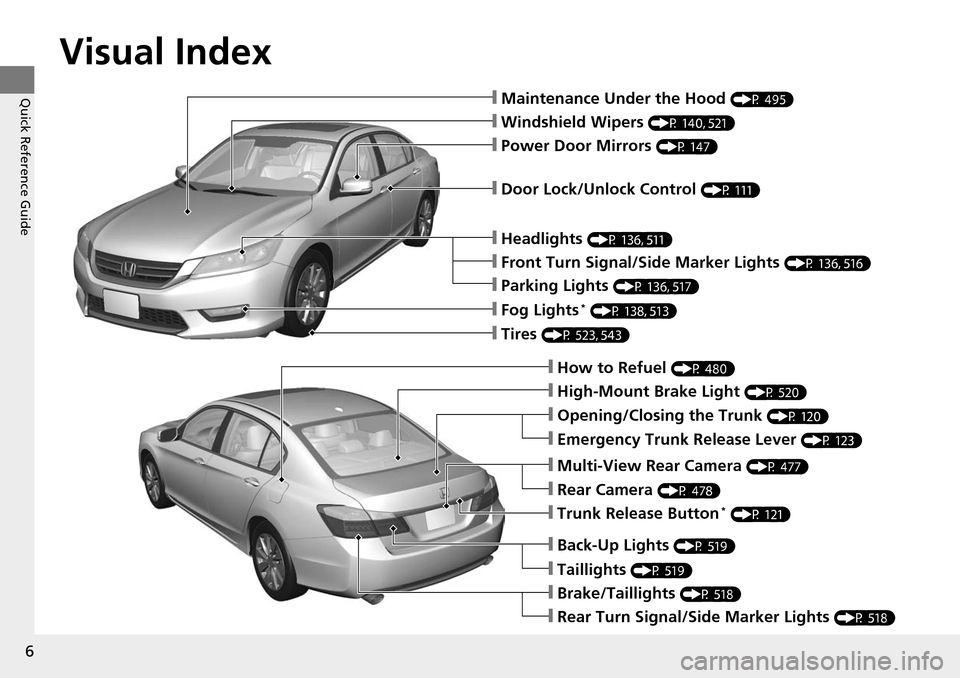
Visual Index
6
Quick Reference Guide❙Maintenance Under the Hood (P 495)
❙Windshield Wipers (P 140, 521)
❙Tires (P 523, 543)
❙Door Lock/Unlock Control (P 111)
❙Power Door Mirrors (P 147)
❙Headlights (P 136, 511)
❙How to Refuel (P 480)
❙High-Mount Brake Light (P 520)
❙Emergency Trunk Release Lever (P 123)
❙Opening/Closing the Trunk (P 120)
❙Parking Lights (P 136, 517)
❙Front Turn Signal/Side Marker Lights (P 136, 516)
❙Fog Lights* (P 138, 513)
❙Multi-View Rear Camera (P 477)
❙Trunk Release Button* (P 121)
❙Back-Up Lights (P 519)
❙Taillights (P 519)
❙Brake/Taillights (P 518)
❙Rear Turn Signal/Side Marker Lights (P 518)
❙Rear Camera (P 478)
Page 10 of 593
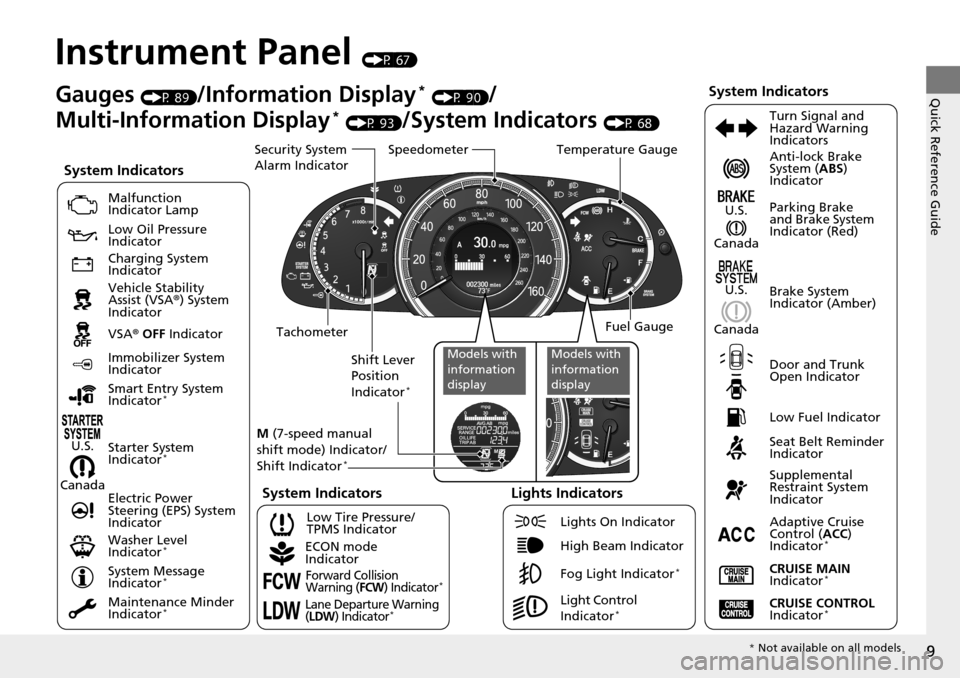
9
Quick Reference Guide
Instrument Panel (P 67)
CanadaU.S.
Low Fuel Indicator
Anti-lock Brake
System (
ABS)
Indicator
Parking Brake
and Brake System
Indicator (Red)
Canada U.S.
Washer Level
Indicator
*
System Indicators
Malfunction
Indicator Lamp
Low Oil Pressure
Indicator
Charging System
Indicator
Vehicle Stability
Assist (VSA ®) System
Indicator
VSA ® OFF Indicator
Low Tire Pressure/
TPMS Indicator
Electric Power
Steering (EPS) System
Indicator
Lights Indicators
Lights On Indicator
High Beam Indicator
Fog Light Indicator
*
Immobilizer System
Indicator
Seat Belt Reminder
Indicator
System Indicators
CRUISE CONTROL
Indicator*
Adaptive Cruise
Control ( ACC)
Indicator
*
CRUISE MAIN
Indicator*
Tachometer Speedometer
Fuel Gauge
Security System
Alarm Indicator
Shift Lever
Position
Indicator
*
Gauges (P 89)/Information Display* (P 90)/
Multi-Information Display
* (P 93)/System Indicators (P 68) Turn Signal and
Hazard Warning
Indicators
System Indicators
Temperature Gauge
M (7-speed manual
shift mode) Indicator/
Shift Indicator
*
Maintenance Minder
Indicator*
Smart Entry System
Indicator*
Starter System
Indicator*
System Message
Indicator*
ECON mode
Indicator
Forward Collision
Warning (FCW) Indicator*
Lane Departure Warning
(LDW) Indicator*Light Control
Indicator*
Door and Trunk
Open Indicator Brake System
Indicator (Amber)
Supplemental
Restraint System
Indicator
Canada U.S.Models with
information
displayModels with
information
display
*
Not available on all models
Page 12 of 593
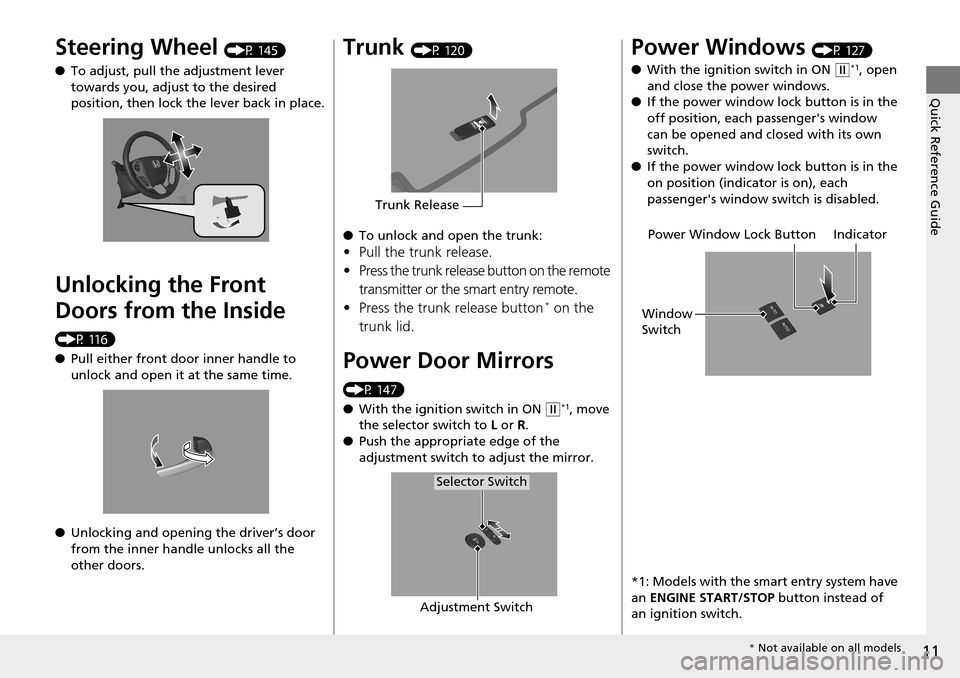
11
Quick Reference Guide
Steering Wheel (P 145)
● To adjust, pull the adjustment lever
towards you, adjust to the desired
position, then lock the lever back in place.
Unlocking the Front
Doors from the Inside
(P 116)
●Pull either front door inner handle to
unlock and open it at the same time.
● Unlocking and opening the driver’s door
from the inner handle unlocks all the
other doors.
Trunk (P 120)
● To unlock and open the trunk:
•Pull the trunk release.
• Press the trunk release button on the remote
transmitter or the smart entry remote.
• Press the trunk release button
* on the
trunk lid.
Power Door Mirrors
(P 147)
● With the ignition switch in ON
(w*1, move
the selector switch to L or R .
● Push the appropriate edge of the
adjustment switch to adjust the mirror.
Trunk Release
Selector Switch
Adjustment Switch
Power Windows (P 127)
● With the ignition switch in ON
(w*1, open
and close the power windows.
● If the power window lock button is in the
off position, each passenger's window
can be opened and closed with its own
switch.
● If the power window lock button is in the
on position (indicator is on), each
passenger's window switch is disabled.
*1: Models with the smart entry system have
an ENGINE START/STOP button instead of
an ignition switch.
Power Window Lock Button
Window
Switch Indicator
*
Not available on all models
Page 23 of 593
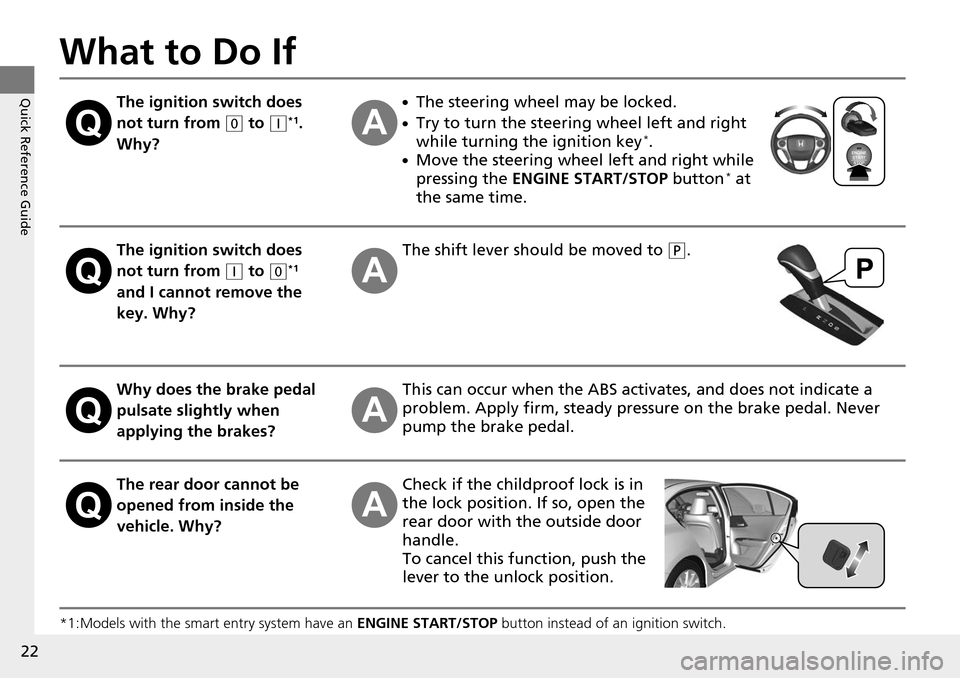
22
Quick Reference Guide
What to Do If
*1:Models with the smart entry system have an ENGINE START/STOP button instead of an ignition switch.
The ignition switch does
not turn from
(0 to (q*1.
Why?
●The steering wheel may be locked.
●Try to turn the steering wheel left and right
while turning the ignition key*.
●Move the steering wheel left and right while
pressing the ENGINE START/STOP button* at
the same time.
The ignition switch does
not turn from
(q to (0*1
and I cannot remove the
key. Why?
The shift lever should be moved to (P.
Why does the brake pedal
pulsate slightly when
applying the brakes?This can occur when the ABS activates, and does not indicate a
problem. Apply firm, steady pressure on the brake pedal. Never
pump the brake pedal.
The rear door cannot be
opened from inside the
vehicle. Why?Check if the childproof lock is in
the lock position. If so, open the
rear door with the outside door
handle.
To cancel this function, push the
lever to the unlock position.
Page 24 of 593
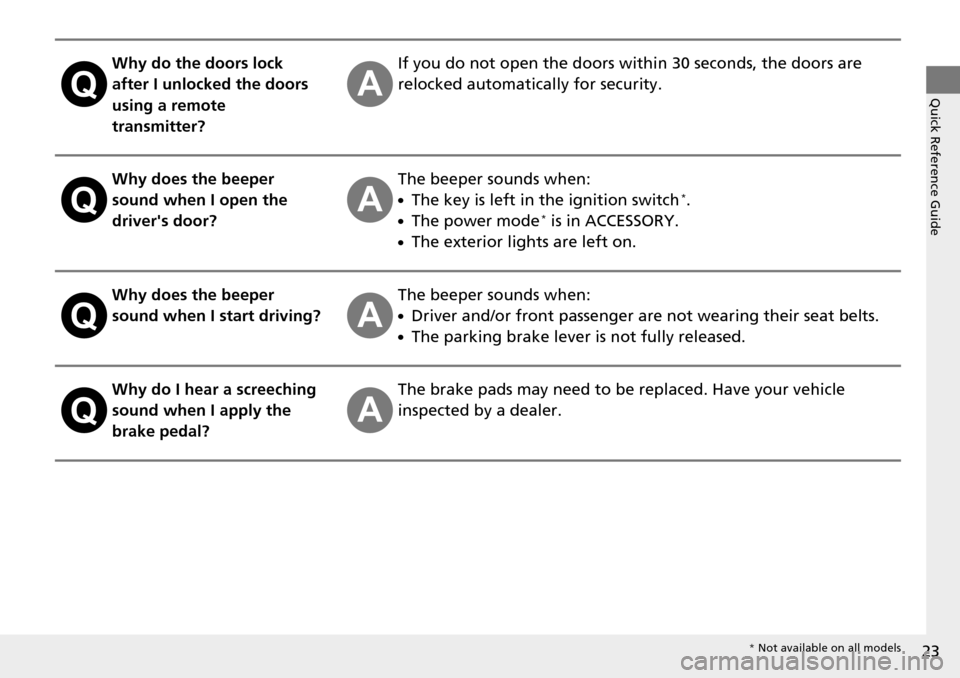
23
Quick Reference Guide
Why do the doors lock
after I unlocked the doors
using a remote
transmitter?If you do not open the doors within 30 seconds, the doors are
relocked automatically for security.
Why does the beeper
sound when I open the
driver's door?The beeper sounds when:
●The key is left in the ignition switch*.
●The power mode* is in ACCESSORY.
●The exterior lights are left on.
Why does the beeper
sound when I start driving?The beeper sounds when:
●Driver and/or front passenger are not wearing their seat belts.
●The parking brake lever is not fully released.
Why do I hear a screeching
sound when I apply the
brake pedal?The brake pads may need to be replaced. Have your vehicle
inspected by a dealer.
* Not available on all models
Page 31 of 593
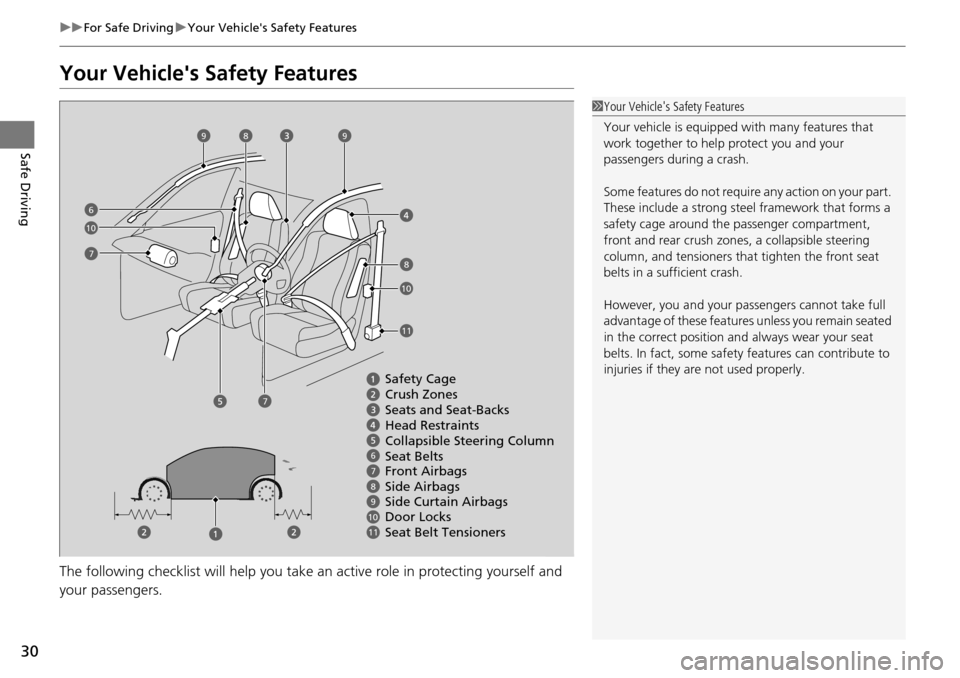
30
uuFor Safe Driving uYour Vehicle's Safety Features
Safe Driving
Your Vehicle's Safety Features
The following checklist will help you take an active role in protecting yourself and
your passengers.
1 Your Vehicle's Safety Features
Your vehicle is equipped wi th many features that
work together to help protect you and your
passengers during a crash.
Some features do not require any action on your part.
These include a strong steel framework that forms a
safety cage around the passenger compartment,
front and rear crush zone s, a collapsible steering
column, and tensioners that tighten the front seat
belts in a sufficient crash.
However, you and your passe ngers cannot take full
advantage of these features unless you remain seated
in the correct position and always wear your seat
belts. In fact, some safety features can contribute to
injuries if they are not used properly.
67891011
Safety Cage
Crush Zones
Seats and Seat-Backs
Head Restraints
Collapsible Steering Column
Seat Belts
Front Airbags
Side Curtain Airbags
Door Locks Side Airbags
Seat Belt Tensioners
7
7
99
8
8
10
10
6
11
Page 32 of 593

31
uuFor Safe Driving uYour Vehicle's Safety Features
Safe DrivingFor the safety of you and your passengers, make a habit of checking these items
each time before you drive.
• After everyone has entered the vehicle, be sure all doors are closed and locked.
Locking the doors helps prevent an occupant from being ejected and an outsider
from unexpectedly opening a door.
2 Locking/Unlocking the Doors from the Inside P. 116
•Adjust your seat to a position suitable for driving. Be sure the front seats are
adjusted as far to the rear as possible while allowing the driver to control the
vehicle. Sitting too close to a front airbag can result in serious or fatal injury in a
crash.
2 Adjusting the Seats P. 148
•Adjust head restraints to the proper position. Head restraints are most effective
when the center of the head restraint aligns with the center of your head. Taller
persons should adjust their head restraint to the highest position.
2 Adjusting the Head Restraints P. 151
•Always wear your seat belt, and make sure you wear it properly. Confirm that any
passengers are properly belted as well.
2 Fastening a Seat Belt P. 35
•Protect children by using seat belts or chil d seats according to a child's age, height
and weight.
2 Child Safety P. 52
■Safety CheckList1Safety CheckList
If the door and trunk open indicator is on, a door
and/or the trunk is not co mpletely closed. Close all
doors and the trunk tightly until the indicator goes
off. 2 Door and Trunk Open Indicator P. 74
Models with information display
Models with multi-information display
Page 54 of 593
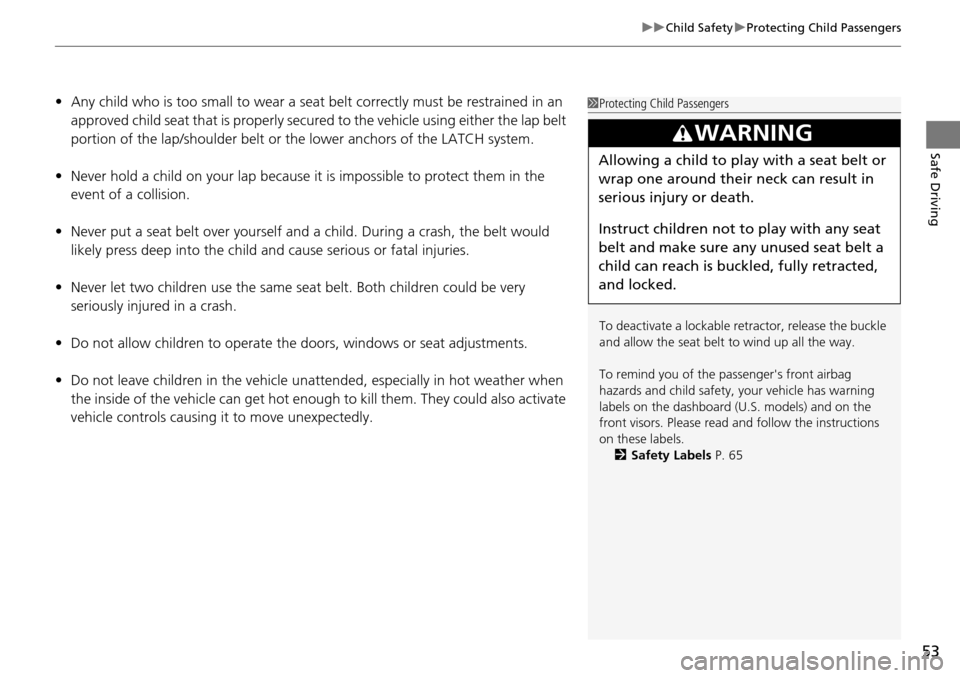
53
uuChild Safety uProtecting Child Passengers
Safe Driving
• Any child who is too small to wear a seat belt correctly must be restrained in an
approved child seat that is properly secured to the vehicle using either the lap belt
portion of the lap/shoulder belt or the lower anchors of the LATCH system.
• Never hold a child on your lap because it is impossible to protect them in the
event of a collision.
• Never put a seat belt over yourself and a child. During a crash, the belt would
likely press deep into the child and cause serious or fatal injuries.
• Never let two children use the same seat belt. Both children could be very
seriously injured in a crash.
• Do not allow children to operate the doors, windows or seat adjustments.
• Do not leave children in the vehicle unattended, especially in hot weather when
the inside of the vehicle can get hot enough to kill them. They could also activate
vehicle controls causing it to move unexpectedly.1Protecting Child Passengers
To deactivate a lockable retractor, release the buckle
and allow the seat belt to wind up all the way.
To remind you of the pa ssenger's front airbag
hazards and child safety, your vehicle has warning
labels on the dashboard (U.S. models) and on the
front visors. Please read and follow the instructions
on these labels. 2 Safety Labels P. 65
3WARNING
Allowing a child to play with a seat belt or
wrap one around their neck can result in
serious injury or death.
Instruct children not to play with any seat
belt and make sure any unused seat belt a
child can reach is buckled, fully retracted,
and locked.